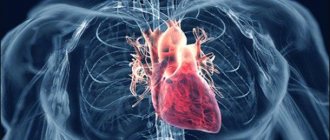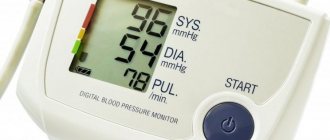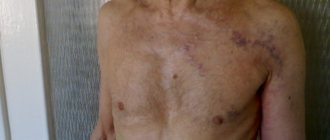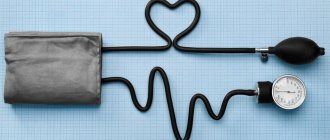Blood pressure is constantly changing; this is a normal, completely physiological phenomenon. We are talking about a dynamic, not a static indicator. Therefore, in medical science and practice, a single norm and a range of digital values have long been established.
At the moment, an arterial reading is considered normal within the range of 140 to 90 mmHg (the maximum permissible option) or 100 to 70, not lower. If the tonometer readings change smoothly throughout the day, this is normal. Otherwise, they talk about pathological conditions.
Sudden jumps in blood pressure are dangerous for the development of severe complications on the brain, heart, kidneys, and vision, potentially fatal to the patient.
A difference of no more than 20-40 mmHg per day is considered adequate and physiological. Athletes and manual workers do not count, since the characteristics of their activities are associated with unstable blood pressure.
What are the dangers of sudden changes in blood pressure levels?
Changes in tonometer readings pose a colossal danger to the health and life of the patient. Older people, 50 and older, are at greatest risk.
What threats await patients:
- Stroke. In other words, acute cerebrovascular accident. It has two clinical forms: ischemic with the development of a sharp disruption of tissue trophism and subsequent necrosis. The second possible option is a hemorrhagic stroke with the development of hemorrhage into the membranes of the brain and the formation of a hematoma.
The second type is much more dangerous, since additional damaging factors are observed: mass effect, that is, compression of cerebral structures by a blood clot, etc. Unfortunately, with sudden changes in blood pressure, it is the second type that is formed.
It has an increased potential lethality. It has a worse prognosis and is characterized by frequent relapses (up to 60% of patients experience a second hemorrhagic stroke within 5 years after the first). Relapse is considered more dangerous and often proves fatal.
- A sharp jump is dangerous for a heart attack. A heart attack is determined by the development of an acute circulatory disorder of the heart muscle. Extensive varieties lead to rapid death due to acute heart failure or organ failure.
- Visual impairment, up to permanent blindness without prospects for restoration of function.
- Fainting conditions. Caused by impaired cerebral circulation. Loss of consciousness in itself does not pose a great danger to life, provided that the phenomenon occurs at home. But fainting can catch a patient at the most inopportune moment: on the road, on the stairs. This is fraught with serious injuries and injuries, including death.
- Stupor, coma. Develop in rare cases. But the prospects for removing patients from such conditions are very vague. Many domestic and foreign authors point to this. Coma often accompanies strokes and heart attacks, going hand in hand with them.
- Acute renal failure with typical symptoms.
All of these consequences are practically irreversible and lead to severe disability.
Hence the logical conclusion: if you have a tendency to have unstable blood pressure readings, you should immediately consult a doctor to take control of your own health.
How to bring your blood pressure back to normal
Everyone suffers from changes in blood pressure, regardless of whether it has risen by several units or fallen.
The indicators displayed by the tonometer can be influenced by many factors, both within the body and a banal change in weather.
You can normalize blood pressure with medications, folk remedies, or infusions.
Pharmaceutical tinctures
Hypertension is a common disease among people of all ages. Your blood pressure may “jump” quite suddenly, and your home medicine cabinet will be stocked with medications.
In this case, tinctures of medicinal herbs will come to the rescue, which it is advisable to have in the refrigerator. They run out much slower than high blood pressure pills.
All pharmacies offer a wide selection of alcohol-based products that effectively lower blood pressure by several units. Most often, hypertensive patients take the following infusions:
Valerian officinalis alcohol based
The infusion has all the necessary qualities to lower blood pressure, relieve spasms, and produce a calming effect.
Motherwort
The second popular infusion for lowering blood pressure. The principle by which this remedy works is in many ways similar to valerian tincture.
Peony
It has a mild sedative effect on the human autonomic nervous system. It not only normalizes blood pressure, but also puts the blood vessels in order.
Folk remedies
In folk medicine there are remedies and recipes that will help reduce blood pressure, but they should not completely replace taking medications. But, knowing about some of them, you can normalize your blood pressure when you don’t have pills at hand.
Garlic
A clove of this spicy spice can not only boost immunity and fight viruses, but also lower high blood pressure. This is possible due to the content of allicin, which has a positive effect on the heart muscle.
Its ease of use makes garlic an accessible means of preventing high blood pressure. It is enough to add one clove to your food throughout the day. You need to eat garlic for three days, then stop for two days.
Honey
Due to its rich composition, honey does an excellent job of normalizing blood pressure. In folk medicine, recipes are often used in which it is the main component.
At the same time, not only pressure indicators decrease, but also the overall composition of the blood improves, the vessels become more elastic.
One of the recipes consists of raspberries, honey and water. You will need to pour boiling water (200 ml) into 100 g. raspberries, leave until the water reaches room temperature. Add one tablespoon of any honey to the cooled infusion and drink the product before bed.
Causes of sudden jumps in blood pressure within small and wide limits
The reasons for the development of frequent changes in tonometer readings are varied. Almost always they are pathological in nature. That is, they are caused by certain diseases.
Cerebrovascular accident
Chronic, but not sufficient for the onset of acute ischemia and tissue necrosis. More often we talk about diseases of the spinal column (osteochondrosis of the neck), compression of the arteries that supply cerebral structures. For example, vertebrobasilar insufficiency makes itself known in a similar way.
Hypothalamic syndromes, especially the neuroendocrine form
Accompanied by a violation of adequate regulation of blood pressure levels. Such a small brain appendage as the hypothalamus is responsible for thermoregulation, controls vascular tone and much more.
When the function of individual nuclei (clusters of neurons) is impaired, the pressure constantly jumps. This pathology is popularly called vegetative-vascular dystonia.
There is no such diagnosis in the international classifier of diseases; it is not an independent nosological unit, but a “garbage” designation, which is like a label attached to any incomprehensible case by inexperienced doctors.
Pathological conditions of the kidneys and excretory system
There are quite a few options here: pyelonephritis, nephritis, nephropathy, renal failure, and other diseases.
All of them are associated with severe hemodynamic disturbances and, as a result, the development of unstable hypertension. The more advanced the condition, the higher the likelihood of an unfavorable course of the process.
Heart failure associated with impaired cardiac output
Hypertension with an increase in only the upper level is more typical; significant jumps in blood pressure levels are less common. If severe instability of the condition develops, we are talking about an advanced disease.
Hormone production disorders
If the pressure fluctuates, perhaps the reason lies in endocrine disorders.
There are also many options here: thyrotoxicosis with the development of excess thyroid hormones, hypercortisolism with increased cortisol concentrations, diabetes mellitus, which even provokes generalized lesions of the whole body; pressure can rise and fall within a few hours.
It is also possible to change the level of hormonal substances of the pituitary gland. We are talking about a heterogeneous group of conditions with similar symptoms from the cardiovascular system.
Causes of pressure instability
Periodic instability of blood pressure by 10-15 mmHg is considered acceptable. Art., caused by a change in physical activity during the day, food intake, or strong emotion. It passes quickly and leaves no consequences.
However, rapid changes in blood pressure that worry you every day require finding out the cause.
External factors
In case of sudden pressure surges, the following exogenous irritants should be eliminated:
- Smoking. Nicotine in cigarettes causes spasm of peripheral blood vessels. After 1.5-2 hours, when the effect of the substance ends, the arteries dilate again and the blood pressure decreases, and the body requires a new cigarette. After quitting smoking, a person feels better over time, partly because blood pressure stabilizes.
- Alcohol abuse. Constant consumption of alcoholic beverages threatens health problems, causing pancreatitis, heart disease, and unstable blood pressure. Eliminating this factor allows you to normalize the condition and avoid deadly complications.
- Taking tonic drinks. Drinking coffee, strong tea and caffeine-containing products leads to increased secretion of adrenaline by the adrenal glands. Due to vasoconstriction, systolic pressure (upper) increases, heart rate and breathing increase, and blood sugar increases. As the drink is eliminated, vascular tone may normalize. However, if use occurs consistently frequently, over time the adrenal glands become exhausted and blood pressure becomes low.
- Poor nutrition. In particular, the abuse of too salty and fatty foods for a long time threatens instability of blood pressure after eating and a tendency to increase it.
- Physical inactivity. Lack of physical activity, especially in old age, leads to such manifestations as irregular heart rhythm, hypertension, and general weakness. Dosed activity and light exercise will help maintain the normal tone of the nervous system, which regulates blood pressure levels.
- Excessive physical activity. To maintain health, you need to adhere to moderation in everything, so athletes who are too persistent may also find that their blood pressure rises after training.
- Constant stress. Refusal to get proper rest, insomnia, and being overloaded with problems take the nervous system out of rhythm. As a result, psychosomatic diseases may occur, including interruptions in blood pressure, especially in the evening. Mastering the method of autogenic training and relaxation allows you to avoid, and in some cases even cure, neuroses in men and women.
- Meteosensitivity. Often, the dependence of well-being on the weather begins to manifest itself from infancy. The child becomes capricious and restless. As adults, people have headaches and high blood pressure, sleep is disturbed due to rain and strong winds. Such manifestations are especially frequent in the fall.
Diseases manifested by unstable blood pressure
Among these diseases are the following:
- Cervical osteochondrosis. A person is bothered by neck pain, headache, dizziness, which usually appears in the morning after sleep and gets worse after being in an uncomfortable position for a long time. In addition, there is often noise in the ears, nausea and sudden surges in blood pressure.
- Panic attack. This is an abruptly onset attack of severe anxiety, accompanied by tachycardia, increased blood pressure, increased breathing, dizziness, sweating, trembling, a feeling of fear of death, and fainting. A panic attack is a consequence of disturbances in the functioning of the autonomic nervous system. Usually the paroxysm lasts a short time, but can last for 12 hours. A panic attack ends with excessive urination and a feeling of powerlessness.
- VSD of mixed type in adolescents (12-18 years old). During puberty and hormonal changes, blood pressure jumps both upward and downward are common. Usually by the age of 20 the condition normalizes without treatment.
- Gestosis in pregnant women. In the first trimester of pregnancy, blood pressure normally tends to drop. From the second half of pregnancy, there is a risk of developing preeclampsia, which is manifested by edema, increased blood pressure and protein in the urine. Without treatment, this condition is dangerous for both the woman and the fetus.
- Thyroid diseases. Lack of thyroid function is called hypothyroidism. It is accompanied by a decrease in blood pressure. In atypical forms of hypothyroidism, hypotension rarely occurs. A sign of thyrotoxicosis (excess of thyroid hormones) is hypertension due to the systolic indicator.
If symptoms of the above diseases occur, consult a doctor! Properly prescribed therapy will avoid serious complications.
Other reasons
There are also some other conditions in which blood pressure may vary throughout the day.
Among them are:
- Traumatic brain injury (TBI). After an injury, symptoms associated with an imbalance in the autonomic nervous system often occur, for example, dizziness, temples may throb and blood pressure may jump. This can be disturbing in the first months with a mild degree of damage and drag on for a long time with a moderate degree.
- After surgery to remove the gallbladder (cholecystectomy), the so-called postcholecystectomy syndrome occurs. Symptoms include tachycardia, chills, feeling unwell shortly after eating, and blood pressure rising and falling. The condition is corrected by taking pills.
- Premenstrual syndrome. On the eve of menstruation, some girls experience discomfort and are subject to sudden changes in blood pressure.
- Climax. The onset of menopause and estrogen deficiency in some women lead to menopausal hot flashes. During an attack, the face turns red, blood pressure rises, the pulse quickens, the limbs go numb, and the woman begins to worry and sweat. Hot flashes can occur up to 20 times a day.
- Obesity. Overweight people, especially in old age, often suffer from atherosclerosis and hypertension.
- Migraine. The main symptom of a migraine is pain on one side of the head. It usually affects hypotensive patients, who during an attack note that their blood pressure has risen sharply.
- Parkinson's disease. A fairly rare neurodegenerative pathology causes a decrease in blood pressure. This is also facilitated by the use of symptomatic antiparkinsonian drugs (levodopa), the side effects of which include orthostatic collapse.
- Incorrect selection of antihypertensive drugs for essential hypertension. During the first time after starting to take blood pressure medications, it may jump in different directions. This is aggravated by incorrect calculation of dosages. Severe instability of blood pressure, poor health, lack of improvement within a week - a reason to go to the doctor for treatment adjustment!
- Sudden change in body position. You can read more about this phenomenon in this article.
Taking glucocorticosteroids, analgesics, and combined oral contraceptives can increase blood pressure. Neuroleptics, cardiac drugs, and drugs for local anesthesia lower blood pressure.
Pressure surges are also possible after any operation with anesthesia, so doctors strictly monitor blood pressure in the first days.
Physiological factors
A sharp drop in pressure from high to low may not be pathological. In this case, the following options are possible:
- Puberty. It is extremely complex physiologically, as it is characterized by sharp jumps in blood pressure over a wide range, sometimes within the same day.
The reasons are hormonal imbalance. The concentration of estrogens and androgens increases (in the stronger sex). This is what causes the pressure to jump: the regulation of blood vessels is disrupted, the nature of hemodynamics changes at the general level.
This situation does not pose any danger in most situations, since the body is young, but exceptions are possible. In any case, it is recommended to consult with your treating specialist so as not to miss an important point.
- Elderly age. As age increases, the following phenomena increase: a violation of the rate of fluid filtration by the kidneys, a change in the nature of cerebral, muscle and other blood flow, a change in reception by special cells of the blood vessels and heart. Hence the high risk of a jump in the tonometer reading over a wide range.
Carrying out prevention
If cases of increased pressure are isolated, then this is mainly due to severe stress and overwork. To normalize it, it is enough to stabilize the psycho-emotional state. If the increase in pressure occurs regularly, then it is recommended to reconsider your usual daily routine, nutrition, and also give up bad habits. Among the main recommendations for hypertensive patients, the following should be highlighted:
- refuse spicy, fatty and salty foods;
- provide fractional, nutritious meals;
- lead a more active lifestyle;
- give up smoking, alcohol, drinking strong tea and coffee.
To minimize the risk of hypotension and protect yourself from sudden changes in pressure, you need to normalize your usual lifestyle. To do this you need:
- take regular walks in the fresh air;
- play sports and do exercises;
- consume foods rich in animal proteins;
- get enough sleep;
- enrich your diet with fresh vegetables and fruits.
People prone to constant, sudden changes in pressure are strongly advised to avoid high temperatures and stuffy rooms.
Causes of blood pressure surges in women
They are more variable, since the fairer sex has less stable hormonal levels and experiences more peak states in life.
Among them: menstruation, pregnancy, menopause and the already mentioned puberty.
- During the menstrual cycle, a disturbance in hemodynamics (blood flow through the vessels) develops, temporary but significant and accompanied by changes in blood pressure. Especially in the first and second phases.
- The next characteristic moment is pregnancy. It is determined by alternating hypertension and hypotension, sometimes within a few hours.
- Menopause is always accompanied by jumps in tonometer readings.
Causes of pressure changes
The causes of pressure surges have not been precisely established; the mechanism of this phenomenon is still being studied.
But the provoking factors are well known:
- The life partner of most of us is stress;
- exposure to cold or heat;
- taking certain medications (even according to instructions), including hormonal contraceptives;
- disorders of the kidneys and/or adrenal glands;
- changes in atmospheric pressure (for weather-sensitive people);
- various hormonal problems.
It is obvious that almost all people are at risk. It is no coincidence that arterial hyper- and hypotension are so common throughout the world.
A number of scientists put forward the theory that the main reason for jumps in blood pressure is the body’s reaction to external conditions: shame, fear, anxiety, alcohol, spicy food, etc.
What to do with high and low blood pressure
First aid measures for low and high blood pressure are different, but are applicable only when the levels are stable.
In the case of jumping pressure, it is impossible to predict when the reverse process will occur: for example, when blood pressure spontaneously decreases after a jump, and vice versa.
If you take a drug for high blood pressure, and at this moment there is also a spontaneous decrease in blood pressure, the indicators will become critically low, which is dangerous for the development of cardiogenic shock, after which only 10% of patients survive.
In the case of medications that increase blood pressure, everything can end in a hypertensive crisis and rapid death, so it is not recommended to joke with your health.
In any case, you need to take a horizontal position and move as little as possible to avoid worsening the condition.
It is impossible to figure out the reasons for the jump on your own, and there is no way to help yourself. You need to call an ambulance and decide on the spot the issue of hospitalization in a cardiology hospital to select therapy.
Until the arrival of the emergency room, no additional actions are required: taking medications is prohibited, drinking and eating are also not recommended, so as not to provoke vomiting or the development of a more complex clinical picture.
Taking baths, showers and following the controversial advice of pseudo-doctors is also not worth it. This is a dangerous practice.
You need to measure your blood pressure every 10 minutes. Then the self-monitoring data should be passed on to doctors. That's all there is to it. Nothing more can be done. Everything else should be left to the doctors.
What to do at home
A patient with problematic blood pressure should always have medications with him to improve his health . Take only those prescribed by your doctor. There are more cases when a patient took a neighbor’s “proven” drug and fell ill with a hypertensive crisis than it seems.
Medicines from a pharmacy for hypertension
When to bring down high blood pressure with drugs? Experienced hypertensive patients feel good at 160/80. Over time, the body gets used to and adapts to new indicators. For people who are dealing with blood pressure control for the first time, +20 units to normal upper pressure is already stressful. Doctors do not advise reducing the level to 160 units in young people, and to 130 in people with heart problems, kidney problems, or diabetes. In fact, they are guided by their well-being and the recommendations of the attending physician.
Groups of drugs against hypertension:
- lowering blood pressure (such as ACE inhibitors: Enalapril, Lisinopril);
- diuretic (hydrochlorothiazide, cyclomethiazide);
- beta-blockers (Carvedilol, Atenolol);
- sartans (Losartan, Eprosartan);
- calcium channel blockers (Amlodipine, Verapamil).
Enalapril is a good remedy for high blood pressure
Traditional medicine recipes
Compresses are true friends of hypertensive patients; they lower blood pressure without pills. The flow of blood to the skin helps bring your health back to normal.
Vinegar and mustard compress
Apple or table vinegar is diluted with half and half water. Wet a piece of natural fabric (linen, cotton, bandage, gauze) and apply to the feet for 5-10 minutes. To urgently relieve blood pressure, add compresses to your calves and neck. Instead of vinegar, you can use mustard plasters or take a hot foot bath with dry powder.
A vinegar compress should be applied to the calves.
Flaxseed in the diet
The source of fatty acids fights atherosclerosis and cholesterol layers in blood vessels. Take 3 tablespoons of the powdered seed in the morning and evening before meals.
Flaxseed helps improve blood vessel health
Tincture of red pine cones
The first techniques already remove 20 units of pressure. Fill a liter jar to the top with washed pine cones, pour vodka to the brim. Leave in a dark place for 2-3 weeks. Collect cones in June-July. Drink a teaspoon of red tincture before meals, with tea or water.
Red pine cone tincture combats high blood pressure
Hypertensive patients are advised to be careful with alcohol tinctures, especially after a stroke.
Medicines from the pharmacy for hypotension
Blood pressure is considered low when it drops by 20% from normal. For men, this figure is 100/65; for women, 95/60 means a reason to get medications. What is in a hypotonic home medicine cabinet:
- drugs that increase blood pressure (Gutron, Ecdisten);
- psychostimulants (caffeine tablets);
- tablets to increase cerebral circulation (Cinnarizine, Piracetam).
Piracetam increases cerebral circulation. Citramon, a universal drug for headaches, also increases blood pressure. The action of caffeine, which stimulates the body's activity.
Symptoms that require urgent medical attention
There are quite a lot of them. In general, there is no exhaustive list of such manifestations. You need to trust your own instincts and seek help in any doubtful case.
An example list could be defined as follows:
- Intense dizziness.
- Inability to breathe normally: shortness of breath, suffocation, especially in a state of complete rest.
- Headache of varying degrees of intensity and localization. Especially pulsating, pulsating, similar to a hammer blow.
- Heartbeat. The pulse rate can be either critically high or low. Both conditions are equally dangerous.
- Fainting, especially of a recurring nature.
- Nausea, vomiting without signs of mitigation of the disease state.
- Chest pain. Pressuring. They radiate to the epigastric region and limbs.
- Visual disturbances, including darkening of the eyes. Flashing of flies. Bright flashes of light (so-called photopsia).
One symptom is enough to contact a doctor. Vigilance is a good practice.
Danger and possible complications
With sharp jumps in arterial parameters, the heart experiences a double load. If a person has a predisposition to developing hypertension or is diagnosed with the disease, the risk of a hypertensive crisis increases. This condition can lead to damage to internal organs.
With a slight increase in blood pressure, there is no need to be afraid of complications. A slight increase in systolic value up to 140 units is not dangerous. Usually the pressure normalizes itself 20-30 minutes after getting rid of the provoking factor. Taking antihypertensive drugs is not required. Such a sharp increase is often found among coffee drinkers and salty food lovers.
If sudden pressure surges up to 140 points occur regularly, it is recommended to consult a doctor. A constant increase in indicators indicates the development of hypertension.
Sharply high blood pressure in a hypertensive patient indicates incorrectly selected therapy. The patient needs to contact his doctor so that he can select another method of treating hypertension. Otherwise, a hypertensive crisis may develop.
High blood pressure can cause complications on important human organs
What needs to be examined?
It is necessary to examine several organs and systems at once.
The help of several specialized specialists is required: an endocrinologist, a cardiologist, a nephrologist (a doctor who deals with problems of the excretory system, including the kidneys), and a neurologist.
The list of studies is standard, aimed at assessing the main structures:
- Collecting anamnesis and oral examination of the patient regarding complaints, lifestyle, bad habits and other characteristic points.
- Study of blood hormone levels: T3, T4, TSH, cortisol. An important diagnostic element.
- Study of blood pressure levels in both arms.
- Using a Holter 24-hour monitor to assess blood pressure readings over a 24-hour period. This is something of a gold standard for early screening.
- General and biochemical blood test.
- Electrocardiography and encephalography. Necessary diagnostic measures. In the competent hands of a qualified medical specialist, these are extremely informative examinations.
- Angiography and/or Dopplerography of vessels of various locations.
In the system, this is quite enough to make and verify a diagnosis.
Caffeine
Caffeine is a biochemical substance found in green and black tea leaves, as well as coffee beans. Entering the human body along with an invigorating drink, caffeine stimulates the work of the heart muscle and negatively affects the tone of the walls of veins and arteries.
A person with a healthy cardiovascular system does not feel the harmful effects of their favorite drinks, and people who are initially prone to high blood pressure experience the corresponding symptoms of a hypertensive crisis.
In this case, sharp pressure surges can reach levels of 140 per 100 mm Hg. Art. and higher. Quitting drinking coffee and tea stabilizes the functioning of blood vessels, and blood pressure normalizes. It is important to remember that green tea, which is considered healthier, contains several times more caffeine than black tea. And people prone to hypertension should avoid drinking coffee altogether.
Condition correction methods
Treating blood pressure changes in humans requires effort. It is impossible to say anything specific without a thorough diagnosis of the root cause.
A systemic examination under the supervision of several specialists is necessary. Treatment is etiological; fighting the effect without eliminating the cause does not make much sense. Symptomatic therapy is carried out with drugs from several pharmaceutical groups.
Blood pressure surges are so complex that it is impossible to provide comprehensive information within the framework of this material.
All medications are selected by a specialist based on the condition, pulse pressure (the difference between upper and lower pressure), and the range of changes in the tonometer reading.
The lifestyle must be adjusted: the amount of fluid consumed, physical activity, and nutrition. It is necessary to give up bad habits. No cigarettes, especially alcoholic beverages even in minimal quantities.
It is not advisable to visit baths and saunas; an increase in ambient temperature will cause an attack of hypertension with possible consequences. It is necessary to carefully follow all the doctor’s recommendations, without retreating a single step.
First aid for low blood pressure - what to do at home
A decrease in pressure is no less dangerous than an increase. When its indicators change, a person may feel dizzy or faint.
The first aid that you need to provide yourself or your loved ones is as follows.
Is low blood pressure 90/60 dangerous? The main symptoms.
The very first aid
- Brew strong tea with the addition of lemon and sugar, or brew natural coffee. Drinking just one cup will be enough; a slice of dark chocolate will help increase blood pressure more effectively.
- After drinking the drink, you will need to sit on the sofa or bed so that your legs are higher than your head (throw them over the back of the sofa, or place pillows under your shins).
- If your condition allows, the dizziness is not severe, then you can take a shower. This contrast procedure is very good at increasing blood pressure at home.
- An effective way is to put a pinch of table salt under your tongue. You will need to keep it until all the crystals are completely dissolved. This method is not suitable for everyone; many may not like the salty taste in their mouth. But salt helps raise blood pressure. After dissolving it, it is advisable to drink clean water without gas.
Preventive measures
Prevention is not very difficult. You need to follow simple tips:
- You should not consume salt in excessive quantities. But you shouldn’t completely abandon this product. Everything is at the discretion of the specialist. It would be a good idea to consult a nutritionist to adjust your diet.
- The diet needs to be changed: more plant foods, less fatty, fried, smoked, sweet. No canned or semi-finished products. They are too salty.
- You need to adhere to an optimal physical activity regimen. No overload. Light therapeutic exercises only. Otherwise, there is a high risk of stroke or heart attack.
It is also recommended to regularly undergo preventive examinations from the specialists described above. In the system, this is enough to stabilize blood pressure.
Sudden changes in blood pressure are fraught with dangerous complications, sometimes fatal. Urgent qualified medical assistance is needed. Treatment is carried out under the supervision of a doctor. Amateur activity is strictly unacceptable. The consequences can be unpredictable.
Features of treatment
If your blood pressure jumps, only a doctor can tell you how to normalize it after a diagnosis. However, it is important to consider how serious the deviation from the norm is. If it does not exceed 10 mm Hg. Art. per day, then this is considered a physiological norm and no therapeutic measures are required.
Hypotonic people can use improvised means, in particular, such as tea or coffee. If the condition does not improve, then you should immediately consult a doctor. With periodic hypertension, you need to change your lifestyle, adjust your usual diet and give up bad habits. Light physical activity is also recommended.
When the pressure jumps sharply, you definitely need to calm down. It is important to try to breathe deeply and evenly. Clothes should not hinder movement and for this you need to try to take a comfortable position. A little rest will help lower your blood pressure monitor. Be sure to take medications prescribed by your doctor and wash with cold water. If the patient's condition does not improve, then you should call an ambulance.
If you have hypotension, it is not recommended to make sudden movements. If a decrease in indicators is observed in the morning, then it is important to get out of bed very slowly. A cup of brewed strong coffee will help raise your blood pressure. In addition, it improves well-being. You can suck the salt by holding it under your tongue. Glucose or sweet tea will help increase blood pressure.
With weather dependence, it is necessary to increase the body's adaptive abilities. To do this, you need to give up bad habits, normalize your sleep and rest patterns, and devote enough time to physical activity. In addition, it is recommended for weather-sensitive people to rest more on unfavorable days, as well as take medications to increase or decrease blood pressure, it all depends on its indicators. It is also worth consulting a psychotherapist or psychologist
Pressure fluctuations in vegetative-vascular dystonia
Vegetative-vascular dystonia of the hypertensive type is characterized by a sharp rise in blood pressure above 140/90 mm Hg. The disease develops in the presence of functional disorders of the cerebral cortex - in the hypothalamus and limbic system. Against the background of increased activation of the autonomic centers, sympathetic nervous and adrenal systems, the minute volume of blood circulation, the tone of the vascular walls, and the production of neurohormones increase.
Vegetative-vascular dystonia is a common cause of a sharp increase in blood pressure and increased heart rate in women.
The patient experiences vegetative-vascular attacks with symptoms typical of arterial hypertension:
- headache;
- dizziness;
- pain in the myocardium;
- cardiopalmus;
- pressure rise;
- chills;
- feeling of lack of air;
- increased body temperature;
- hyperemia or pallor of the face;
- increased anxiety;
- reduced performance.
The duration of attacks ranges from several minutes to 3 hours.
The therapeutic regimen is individual. Drugs from the group of adrenergic blockers are considered optimal for VSD.
Sudden pressure surges - reasons
Changes in blood pressure occur at any age, even in youth. Why does the pressure fluctuate? First of all, due to overexcitation of the nerve centers caused by overwork, a busy day at work, restless sleep, and frequent stress. As a result, impulses are poorly transmitted and disrupt adaptation mechanisms.
Provocateurs of the condition include:
- change in climatic conditions and time zones;
- long flight;
- blood loss;
- sudden standing up;
- allergy.
And finally, infection of the body.
Why does blood pressure fluctuate in older people?
In adulthood, the list of reasons that provoke fluctuations in blood pressure is no different. These are the same:
- excess weight;
- physical inactivity;
- osteochondrosis of the cervical spine;
- stress;
- bad habits;
- genetic predisposition;
- taking medications that destabilize blood pressure;
- errors in nutrition;
- chronic pathologies.
What to do if your blood pressure increases during menopause. A woman’s feeling of uselessness, weakness and the associated anxiety only aggravates the situation. It is important to maintain a positive attitude so that sudden hot flashes do not become a health risk, to know the blood pressure norm corresponding to a specific age and control it to avoid cardiac accidents.
Possible reasons
In life, conditions often arise that contribute to fluctuations in blood pressure in the evenings. In healthy people, this is mainly stress and overeating; let’s look at each case in more detail.
Physiological factors
The physiological mechanisms leading to increased blood pressure at night have not been fully established.
They are mainly related to:
- excessive activation of the sympathetic nervous system;
- an increase in the volume of circulating blood due to the redistribution of plasma in the vascular bed.
The reasons why blood pressure jumps also include the influence of external factors:
- environmental conditions (high air temperature);
- physical exercise;
- smoking;
- too heavy dinner before bedtime;
- increased sodium content in food;
- drinking tonic drinks (coffee);
- alcohol;
- overexcitement, stress (panic attacks).
A rise in blood pressure in the evening is also possible due to the characteristics of a particular organism. Variations depend on heredity, mood, gender (men are more often affected) and personality type. Diurnal fluctuations increase significantly in elderly patients.
In women, a connection with the onset of menopause has been proven. After menopause, systolic blood pressure does not decrease sufficiently at night. Presumably this is due to the development of arterial hypertension against the background of a progressive decrease in estrogen synthesis.
Pathological factors
An increase in pressure after sunset can also develop as a result of pathological processes in the body. This condition is often diagnosed in people receiving treatment with high doses of glucocorticosteroids.
Among the main pathological causes of elevated nocturnal blood pressure are:
- sleep disturbance;
- orthostatic hypotension;
- obstructive sleep apnea;
- autonomic dysfunction;
- arterial stiffness;
- diabetic nephropathy.
Increased night pressure is diagnosed in the early stages of diabetes mellitus and is considered a prognostic parameter for the development of microalbuminuria. Low blood pressure in the morning and high blood pressure in the evening usually indicate renal dysfunction of various origins.
Excessive sympathetic activity, as a consequence of impaired cardiopulmonary reflex, occurs in patients after heart transplantation. A certain role is assigned to the use of immunosuppressants.
Blood pressure is affected by disruption of the endocrine system. Thyrotoxicosis in nodular goiter leads to increased synthesis of the hormones thyroxine and triiodothyronine. Their excess provokes a narrowing of the lumen of blood vessels, increased heart rate and hypertension.
An increase in systolic blood pressure and a decrease in diastolic blood pressure is considered characteristic. An increase in pressure in the evenings is also observed with Cushing's syndrome and pheochromocytoma.
First aid
If a person’s blood pressure has decreased or increased significantly, it is necessary first of all to reassure the patient, because at such moments he may experience fear, which can develop into a panic attack.
Next, you need to open the windows in the room to provide fresh air. It is better to remove clothing from the upper body so that nothing puts pressure on the chest, neck and does not interfere with breathing fully. These measures are needed both with increased and decreased blood pressure. Further actions vary.
If your blood pressure is high, you should proceed as follows:
- Place the patient, preferably in a semi-sitting position, so that a lot of blood does not flow into the brain.
- Give me an anti-hypertension pill to take.
- If your heart hurts, put Nitroglycerin under your tongue.
If your blood pressure is low, you should do the following:
- Place the patient on his back, elevate his lower limbs with a pillow.
- Give a Caffeine tablet, which will help increase blood pressure.
When providing first aid, it is necessary to measure blood pressure every 15 minutes. If within half an hour the patient does not feel better or the condition worsens sharply with severe symptoms, doctors should be called.
Measuring pressure will allow you to observe the dynamics and evaluate the effectiveness of the medications taken
Congenital or acquired heart disease
Heart pathologies have a direct impact on blood pressure. This is due to the fact that this organ plays the role of a kind of pump. Many indicators of the body’s homeostasis, including blood pressure levels, depend on the effectiveness of its work. There are both congenital pathologies acquired at the stage of the formation of the blood supply system, and acquired ones.
The first group of diseases occurs as a result of intrauterine infections, genetic disorders or exposure to harmful factors on the body of a pregnant woman and the fetus.
Heart diseases
The second group of diseases appears after birth and can be caused by the following provoking elements:
- infections;
- injuries;
- the presence of common diseases leading to disruption of the myocardium.
Symptoms of high blood pressure
With a sharp increase in blood pressure, the patient most often feels a severe headache. Other symptoms may appear in the form of dizziness, heart pain, nausea, chills, shortness of breath, weakness, nosebleeds, and frequent urge to urinate. The patient may complain of redness of the skin of the face and chest, insomnia, tinnitus, anxiety or fear.
With a complicated hypertensive crisis, loss of vision, fainting and vomiting occur.
It should be remembered that a sudden rise in blood pressure is dangerous for the development of heart attack and stroke.
Therapeutic measures
Treatment depends on whether the blood pressure is high or low. If the indicator is reduced, it is much easier to normalize it. To do this, just drink a cup of coffee or take ginseng tincture. With a higher value it is more difficult. In this case, it is necessary to take an antihypertensive pill.
But these are only emergency solutions to the problem. Using them will not make your blood pressure problem go away forever. In order to maintain normal blood pressure, it is necessary to approach the issue of therapy comprehensively.
Patients should adjust their diet. You will have to give up all foods that can harm blood vessels and the heart. These include: fast food, sausages, fatty and fried foods, smoked foods, confectionery, canned food, high-fat dairy products, sweet carbonated drinks.
Patients should eat more vegetables, fruits, herbs, and berries. Choose low-fat varieties from meat and dairy products. When it comes to cereals, give preference to dark types.
Without giving up bad habits, it is almost impossible to get rid of spikes in blood pressure
If blood pressure increases, patients will need to quit smoking and stop drinking alcohol. Many patients underestimate the importance of this recommendation. Nicotine and alcohol damage blood vessels, either narrowing their lumen or expanding them. If you don't quit bad habits, pressure changes will bother you regularly.
Special attention should be paid to physical activity. People who are prone to blood pressure fluctuations are recommended to lead an active lifestyle. It will be useful for patients to run, race walk, swim, and perform therapeutic and breathing exercises. At the same time, classes must be carried out correctly so as not to cause harm to the body.











